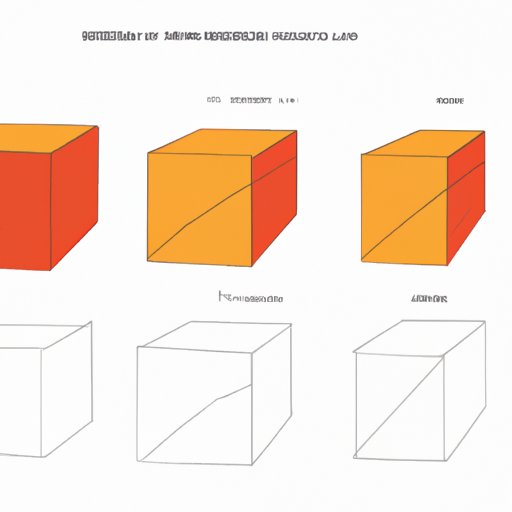
I. Introduction
In geometry, a cube is a three-dimensional figure with six square faces of equal size. Knowing how to find the surface area of a cube is important for a variety of reasons, including practical applications like packing boxes or painting a room. This article will provide a step-by-step guide, visual aids, real-world examples, comparisons with other shapes, and interactive learning tools to help readers understand the concept of surface area and how to apply it in their lives.
II. Step-by-Step Guide
Surface area is the total area of all the faces of a three-dimensional object. For a cube, the formula for finding surface area is:
SA = 6s²
where SA stands for surface area and s stands for the length of one side of the cube. To find the surface area of a cube, simply follow these steps:
- Measure the length of one side of the cube (s).
- Square the length of one side (s²).
- Multiply the squared length by 6 (6 x s²).
- The resulting number is the surface area of the cube (SA).
For example, if one side of a cube measures 4 inches, the surface area can be found by:
- s = 4 inches
- s² = 16 square inches
- 6 x s² = 6 x 16 = 96 square inches
- The surface area of the cube is 96 square inches.
III. Visual Approach
Learning through visual aids can be especially helpful for understanding the concept of surface area. A diagram or image can help reinforce the steps needed to find surface area and make the process more easily understood.
One way to supplement the step-by-step guide is to use clear, well-labeled diagrams or images that illustrate the process of finding surface area. This can help readers more easily visualize the steps of finding surface area and understand the concept.
IV. Real-World Examples
There are many practical applications of finding surface area, including wrapping gifts, calculating how much paint is needed for a room, and building objects like boxes or furniture. By providing real-world examples of how finding surface area is used, readers can better understand why this concept is important and how it can be applied in their own lives.
For example, when wrapping a gift, finding the surface area of the box or object can help determine the amount of wrapping paper needed. Or, when painting a room, knowing the surface area of the walls and ceiling can help determine the amount of paint needed for the job.
V. Comparison with Other Shapes
While the process for finding the surface area of a cube is specific to that shape, it is helpful to compare the surface area of a cube to other common shapes. This can help readers better understand the concept of surface area and how it applies to different types of shapes.
For example, a sphere has a smaller surface area than a cube with the same volume. This is because the sphere has a curved surface, which doesn’t contribute as much to the total surface area. On the other hand, a pyramid with the same base area as a cube will have a smaller surface area overall, as its sides are triangular rather than square.
VI. Interactive Learning
Interactive tools can be a fun and engaging way to learn about surface area. There are many online resources that offer interactive quizzes, diagrams, or animations to help readers practice their knowledge of surface area.
Readers can use these tools to solidify their understanding of surface area and apply it in different scenarios. For example, an interactive quiz may ask readers to calculate the surface area of a variety of objects, while an animation may show the process of finding surface area step by step.
VII. Conclusion
Finding the surface area of a cube is a fundamental concept in geometry that has many practical applications in real life. By following the step-by-step guide, supplementing with visual aids, exploring real-world examples, comparing with other shapes, and practicing with interactive tools, readers can gain a better understanding of surface area and how to apply it in their own lives.
For additional resources on geometry and related topics, readers can consult textbooks, online tutorials, and educational websites. By continuing to practice and learn, readers can develop a deeper understanding of this fascinating field of mathematics.




